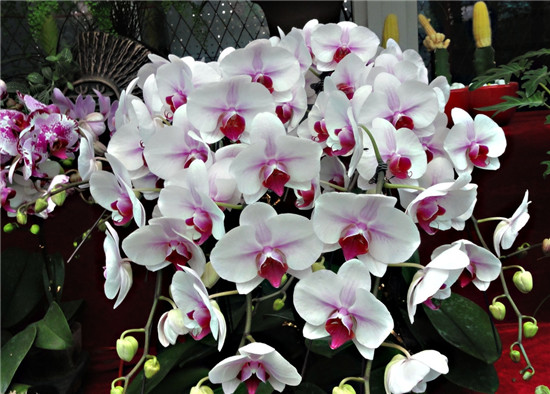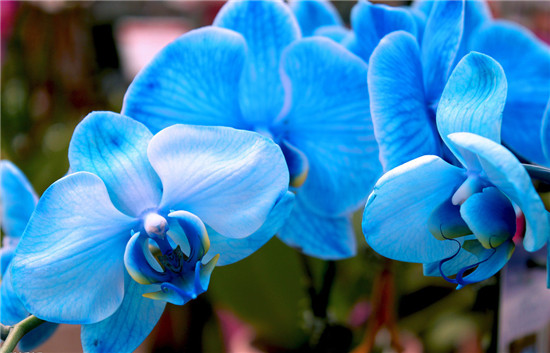How to cultivate butterfly orchids the cultivation methods of butterfly orchids
Phalaenopsis is one of the plants suitable for indoor culture. Most of Phalaenopsis are grown in humid Asia. Let me tell you more about how to grow Phalaenopsis.

On the culture methods of Phalaenopsis
1. Flowerpots: if you are careful enough, you will find that all the Phalaenopsis on the market are grown in white transparent plastic pots. It should be noted that this is not because businesses are unwilling to use good pots to reduce costs, but because the roots of Phalaenopsis need photosynthesis, so the Phalaenopsis roots that you see growing well are green, which is the result of photosynthesis. If you care at home, you can choose colorless and transparent plastic containers of the right size.
2, flower soil: generally raise Phalaenopsis will choose water moss. The quality of water moss is also important. Do not choose over-broken into powder, because water moss has strong water retention, too broken water moss will cause too much water in the root and lead to rot. Because the water moss has good water absorption, you can spread some ceramsite or orchid matrix at the bottom of the pot when raising Phalaenopsis, and then maintain it with water moss.
3. Treatment after flowering: most people receive Phalaenopsis sent by friends or buy Phalaenopsis themselves during the Spring Festival. If they are watered normally, they can usually bloom until March or April. If it is a home-raised Phalaenopsis, the flowers are still bright in mid-May.

4. Phalaenopsis likes the environment of high temperature, high humidity, ventilation and semi-shade. It is not resistant to waterlogging, cannot direct sunlight, cannot accumulate water and is afraid of cold. Wild Phalaenopsis grows mostly in humid tropical areas, so the most suitable temperature for Phalaenopsis growth is 22-28 degrees Celsius. Once the temperature is below 15 degrees Celsius, it will stop growing and die. Put Phalaenopsis in a shady and ventilated place to avoid direct sunlight. The air root of Phalaenopsis is quite many, and its root tip is green and sensitive, so it should be carefully protected and must not touch the root tip, otherwise the root will stop growing.
5. Fertilizer is essential to promote the growth of Phalaenopsis. The principle of fertilizing Phalaenopsis is to apply thin fertilizer frequently, and do not use too thick chemical fertilizer. Nitrogen and potassium fertilizer is applied in the growing period of Phalaenopsis, while phosphorus and potassium fertilizer is applied in the flowering stage, usually once every 1-2 weeks. In addition, Phalaenopsis flowering dormant period can not be fertilized, but in the early flowering and late flowering must be properly supplemented with fertilizer.
Four reasons for the failure of family cultivation:
1. Watering too frequently: friends who cultivate Phalaenopsis are always worried about the lack of water, regardless of whether the cultivation medium is dry or not, watering every day, resulting in serious root rot.

2. The temperature is too low: usually the flowering plants of Phalaenopsis are on the market in early spring, and they are generally appreciated in the living room after buying them home. Although the daily temperature in these places is enough, the night temperature is a little too low. On the other hand, most of the professionally cultivated orchids are in well-equipped greenhouses, in contrast, the temperature and humidity at home are not enough, so the growth of the plant tends to weaken day by day. Therefore, sometimes, no matter how well maintained, orchids still do not blossom.
3. Excessive fertilization: apply fertilizer as soon as there is fertilizer, and do not pay attention to the concentration, thinking that if you apply fertilizer, you will grow faster. It should be noted that Phalaenopsis should be fertilized with thin fertilizer, a small amount of fertilizer for many times. Keep in mind that "replenishment" should not be excessive, or it will be counterproductive.
4. Small plants grow large pots: feel that using large pots can give Phalaenopsis a relaxed environment and sufficient materials. In fact, after using a large basin, the water plant is not easy to dry, it is important to know that Phalaenopsis likes ventilation, ventilation is comfortable.

What if the butterfly orchid thanks?
If your Phalaenopsis is bought by yourself or given by a friend before and after the Spring Festival, it will bloom when you buy it, and there will be no flowers until now (around the end of March). If you want it to continue blooming, you can choose to keep the pedicel and check the root system. If there are rotten roots and dried roots cut off in time, check whether the water moss is rotten, mildew and other adverse conditions, and consider whether it needs to be replaced. Still use a transparent basin, normal watering maintenance, see wet and dry, if the humidity at home is more natural (not big also does not matter), if there is liquid special fertilizer at home to give some natural better (no matter), if the plant is very strong, will soon continue to grow new buds in the front of the original pedicel If the plant is weak and consumes a lot after blooming, it will grow lateral peduncles and buds on the original pedicel and keep blooming until the end of June (this flowering period will be shorter because of the hot climate). Cut off the pedicel after the flower fade and take care of it normally.
If it is domesticated by yourself, it usually begins to grow pedicels and buds (heated houses) around December of the first year, and generally blooms at the end of February and the beginning of March, and the florescence lasts until the end of May. Then practice and want to be the same, if you want to see the flower again, keep the pedicel, normal maintenance, quickly grow lateral peduncle in the pedicel, bud, open.
The above is the whole content of how to cultivate butterfly orchids and the cultivation methods of butterfly orchids. I hope this article can help you. Please continue to follow us.
Consumption is relatively large, normal maintenance to about May, will grow lateral peduncles and buds on the original pedicel, continue to open until the end of June (this florescence will be shorter because the climate is getting hot). Cut off the pedicel after the flower fade and take care of it normally.
If it is domesticated by yourself, it usually begins to grow pedicels and buds (heated houses) around December of the first year, and generally blooms at the end of February and the beginning of March, and the florescence lasts until the end of May. Then practice and want to be the same, if you want to see the flower again, keep the pedicel, normal maintenance, quickly grow lateral peduncle in the pedicel, bud, open.
The above is the whole content of how to cultivate butterfly orchids and the cultivation methods of butterfly orchids. I hope this article can help you. Please continue to follow us.
Related
- Wuhan Hospital Iron Tree Blooming Result Was Instantly Frightened by the Gardener Master
- Which variety of camellia is the most fragrant and best? Which one do you like best?
- What is the small blue coat, the breeding methods and matters needing attention of the succulent plant
- Dormancy time and maintenance management of succulent plants during dormancy
- Minas succulent how to raise, Minas succulent plant pictures
- What are the varieties of winter succulent plants
- How to raise succulent plants in twelve rolls? let's take a look at some experience of breeding twelve rolls.
- Attention should be paid to water control for succulent plants during dormant period (winter and summer)
- Watering experience of twelve rolls of succulent plants
- Techniques for fertilizing succulent plants. An article will let you know how to fertilize succulent plants.



